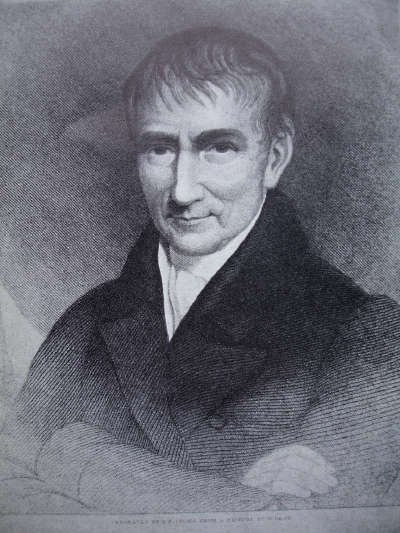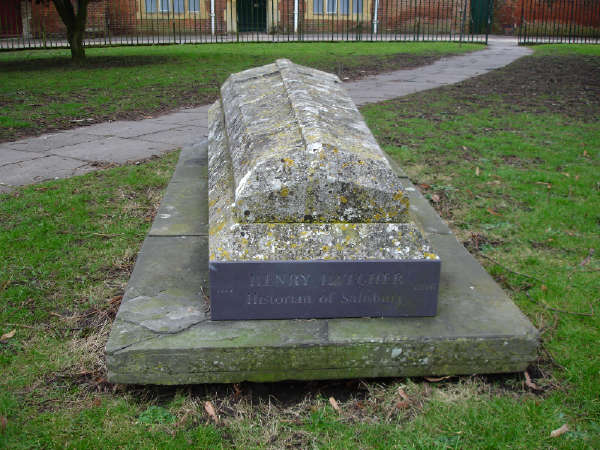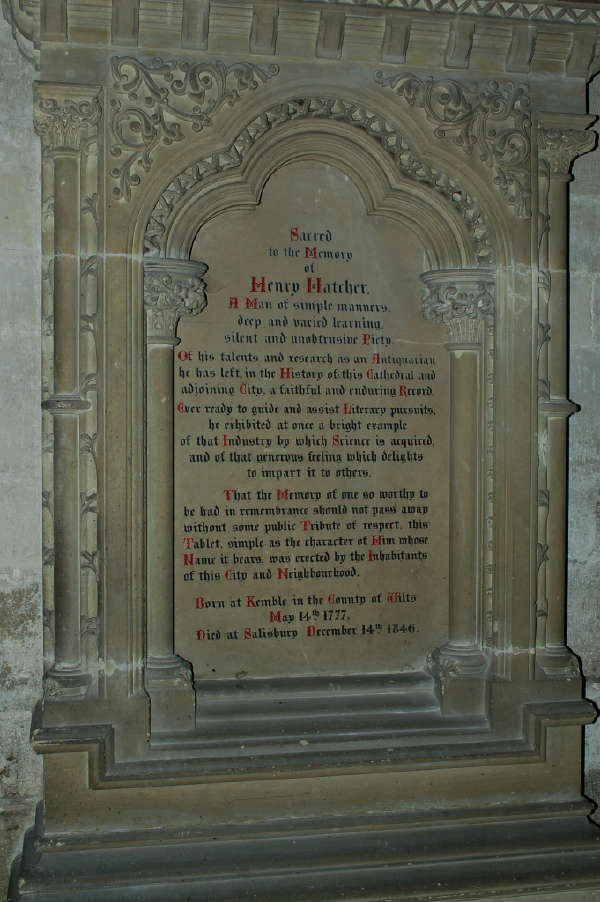Henry Hatcher (1777 - 1846) was an early historian of Salisbury. For a nineteenth century antiquary, his background was unusual: he was a farmer's son. His parents moved from Kemble to Salisbury in about 1790. Young Hatcher was taught by a schoolmaster named West, and was soon found to excel in classics and mathematics. He was a fine linguist, eventually knowing Latin, Greek, French, German, Italian, Spanish, Portuguese, and Dutch. At the age of fourteen he became a junior assistant in West's school, and subsequently held similar posts elsewhere.
In about 1795 he was engaged as an assistant to the historian and archaeologist the Rev William Coxe. Both men helped Sir Richard Colt Hoare (eminent Wiltshire antiquary, commemorated in the cathedral) with a number of historical and descriptive works. In 1801 he helped John Britton with the third volume of his Beauties of Wiltshire.
In 1817 he became postmaster at Salisbury, all the while continuing to assist Coxe. However, in 1822 he resigned as postmaster and opened a private school (with ten pupils) in Fisherton, moving two years later to the site in Endless Street commemorated by the plaque. Private schools seem to have been a growth industry in Salisbury: John Chandler (Endless Street) records that in 1830 there were twenty-four of them. He quotes a letter from Hatcher to his friend and collaborator John Britton: "With half a hundred noisy and idle youths to superintend, it is not possible to give long and steady attention to anything... However, there is one comfort: the trade of a schoolmaster is the best in point of profit that I have yet exercised and I prefer solid pudding to empty praise...it will enable me to do something for old age or a rainy day." Despite these somewhat dismissive words, Hatcher appears to have been an enthusiastic teacher: in 1835 he published a booklet for school use (A Supplement to the Grammar, Containing Rhetorical and Logical Definitions and Rules) categorising figures of speech and giving advice on summarising.
Through all this time, he worked steadily on the history of Salisbury. He had already (in 1814) published An historical account of the Episcopal See and Cathedral Church of Sarum (under the name of William Dodsworth). In 1830 he contributed to the Salisbury part of Britton's Picturesque Antiquities of English Cities. The year 1834 saw the publication of An historical and descriptive account of Old and New Sarum or Salisbury. It is a masterpiece of compression, taking the reader from the earliest times to 1795 in under 200 pages, including a list of prominent people born in Salisbury, a brief history of Wilton, and even the times of postal collections. There is perhaps a hint that the distractions of schoolmastering had led to the project being scaled down: in the preface he says 'the materials from which these pages are drawn were originally collected for the compilation of a regular history of Salisbury. That purpose has long been relinquished.'
He was, however, soon to be given the opportunity to fulfil this aim. In about 1835 Sir Richard Colt Hoare suggested that Hatcher compile the Salisbury part of the History of Modern Wiltshire, using material that Robert Benson, Recorder of Salisbury, had already collected. This he did. The outcome was described by John Chandler as 'a monument of erudition and a painstaking demonstration of the history of the nation embodied in the history of the city'. Unfortunately, Benson and Hatcher disagreed over whose name should appear on the title page and when the work was eventually published in 1843 it carried both names. The dispute was never settled to Hatcher's satisfaction and seems to have darkened his final years. He died suddenly in December 1846 and was buried in St Edmund's.
There is a monument (erected by public subscription) to him in the cathedral (in the wall of the north aisle, near the western crossing). It describes him as 'a man of simple manners, deep and varied learning, silent and unobtrusive piety.' So great was his modesty and willingness that others be given the credit for his efforts that the true extent of his work will probably never be known. He was, however, well respected in the city during his lifetime, and his reputation has grown with the passage of years. The Hatcher Society, which was dedicated to commemorating his life and continuing his antiquarian work, flourished between 1957 and 2000, for much of this time under the chairmanship of Lady Paskin and subsequently Kathy Quinn. A learned periodical (the Hatcher Review) was published between 1974 and 2000. Under the motto 'local history is of more than local interest', it carried contributions initially on the history of Salisbury but later on Wessex generally. Lady Paskin was its editor from 1974 to 1985.

An engraving by G F Storm from a picture by W Gray of Henry Hatcher. The portrait itself is in storage in the Salisbury and South Wiltshire Museum.

Henry Hatcher's grave in St Edmund's Churchyard, Salisbury.

Henry Hatcher's memorial in Salisbury Cathedral on the north wall of the nave, near the western crossing.
A supplement to the grammar containing rhetorical and logical definitions and rules: and rules of abridgment, variation and amplification: compiled and printed for Mr Hatcher's school, Salisbury - published W.B. Brodie, 1835.
An historical account and descriptive account of Old and New Sarum or Salisbury - Henry Hatcher - published Clapperton, 1834.
History of Modern Wiltshire - Hoare, Benson and Hatcher - published John Bowyer Nichols and Son, 1843.
Endless Street - John Chandler - published Hobnob Press, 1983.
The Oxford Dictionary of National Biography entry on Henry Hatcher - author W.P. Courtney, revised by Penelope Rundle.
The Hatcher Review (vol 2 no 12)
Assistance from the Local Studies Librarian:Bruce Purvis, and his colleagues at Salisbury Library, and to Kathy Quinn and Celia Tate of the Hatcher Society.
Click here to go to Henry Hatcher's Plaque Page.
Click here to go to Salisbury Plaques Home Page.
Click here to go to the Salisbury Civic Society's Home Page.